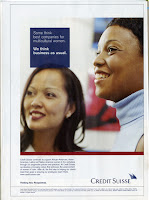
From AdAge.com…
---------------------------
‘My Black Is Beautiful’
P&G Wants to Connect With African-American Women. Najoh Reid Provides the Blueprint and the Rallying Cry.
By Jack Neff
Najoh Tita Reid has one of those classic childhood stories from when she was 4 or 5. One of her white friends wouldn’t let her white doll play with Ms. Reid’s black doll, which she termed “ugly.”
Then her friend pointed out the doll’s resemblance to Ms. Reid, who went home crying. Her mom, after reassuring Ms. Reid, also got her some Essence and Ebony magazines and put up a “Black Is Beautiful” poster in her bathroom. “This being the 1970s,” Ms. Reid said, “it wasn’t hard to find.”
But unlike most people, Ms. Reid, now 34, is in a position to do much more than that. She’s multicultural marketing director for the world’s and country’s biggest advertiser, Procter & Gamble Co. And she’s convinced P&G to start putting its considerable marketing heft – “scale marketing” as they say at the Cincinnati headquarters -- behind a new multibrand campaign called “My Black Is Beautiful.”
Forging bonds
The campaign’s goal is to make all black girls and women feel that way regardless of skin tone or origin and, of course, forge a closer relationship between P&G brands and their black consumers in the process.
The campaign obviously bears some resemblance to the idea behind a globally lauded effort by one of P&G beauty's key competitors, Dove’s “Campaign for Real Beauty” from Unilever. The formula for both: Find a group that feels slighted by popular culture, then position your brand(s) squarely on their side.
But there are some key differences in origin, society and company that make the P&G push groundbreaking and potentially powerful in its own way.
Potentially, that is, because quite uncharacteristically for P&G, this thing isn’t fully thought out yet. Ms. Reid took a hiatus from maternity leave to unveil the concept at the National Association of Black Journalists meeting in Las Vegas earlier this month, where it generated keen interest -- particularly from black anchorwomen, Ms. Reid said -- but so far relatively little coverage.
P&G’s Always and Tampax have established a $50,000 grant, and the company is in talks with women’s organizations to develop a series of community discussions on the issue, with booklets likely to be distributed by Essence, but that’s about it so far.
Bigger potential
Yet the emotional and selling power behind the idea clearly go well beyond Ms. Reid’s playtime experience or a one-off public-relations campaign.
P&G research found that 71% of black women feel they’re portrayed worse than other women in media and advertising. Despite that, they spend on average three times more than the general market on beauty products. The company’s idea is, in part, to give black women the attention warranted by that spending, building “My Black Is Beautiful” over many years to a program “that will stand the test of time,” Ms. Reid said.
Yet it’s also quite of-the-moment, as in P&G’s Sister Souljah moment. The company earned some credibility on the issue by being among the first and certainly the biggest advertiser to pull the plug on Don Imus in April after his infamous remark.
Ms. Reid already had been developing the program, practically since she moved to her new post last year after serving as global brand manager on Pampers. But the Imus controversy led her to believe it was time to act. “This is not one of those things we need to talk about for years,” she said.
“We know the insight to be true. So we said, ‘Let’s start grass roots and work our way toward national advertising,’” Ms. Reid said. “It’s more authentic, for one. It’s a movement that really begins with conversations that mothers and daughters have.”
Timing
Mr. Imus’ remark came about a month before P&G was to hold its first global summit of executives of African descent, which brought 400 individuals to Cincinnati. That was, Ms. Reid realized, a near-perfect platform from which to launch “My Black Is Beautiful” within the company.
Her presentation brought some women to tears, she said. A dark-skinned executive cried because she, too, had been made to feel ugly as a child. A light-skinned executive cried because she’d never felt fully accepted as black.
By trying to celebrate all shades and origins equally, P&G also is looking to traverse a difficult boundary in multicultural marketing: recognizing that many Hispanic women are also black. Few if any beauty marketers have figured out how to market around this. Drug-store chains, for example, get disproportionately heavy beauty business from Hispanic women and disproportionately little beauty business from black women.
Branching out
By extending the “My Black Is Beautiful” umbrella over some Hispanic women, too, P&G is hoping for a multicultural campaign that works in both markets.
Ms. Reid, who started her career as a 17-year-old sales intern in Boston, said she received support from P&G management after enduring a few racial slurs from retailers during that time. She’s part of a legacy of diversity efforts that were a hallmark of former Chairman-CEO John Pepper’s career.
With her new campaign, she hopes to recast some of P&G’s key general-market beauty slogans with new meaning for black women. Olay’s “Love the Skin You’re In,” Pantene’s “Shine” and CoverGirl’s “Every Woman Is a Queen” all can be seen in a new light, she said, alongside “My Black Is Beautiful.”
---------------------------
By the numbers
Percentage of black women who are concerned about the way they’re portrayed in popular media: 77
Percentage of black women who say they’re portrayed worse than any other racial group in media: 71
Percentage of black women who believe black teens are portrayed worse than other racial groups in media: 69
How much an average black woman spends on beauty products compared with the average woman overall: 3 times
Sources: Procter & Gamble Co., P&G/Essence poll


















































